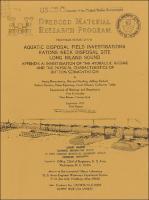Please use this identifier to cite or link to this item:
https://hdl.handle.net/11681/47202Full metadata record
| DC Field | Value | Language |
|---|---|---|
| dc.contributor.author | Bokuniewicz, Henry J. (Henry Joseph) | - |
| dc.contributor.author | Dowling, Michael | - |
| dc.contributor.author | Gebert, Jeffrey A. | - |
| dc.contributor.author | Gordon, Robert | - |
| dc.contributor.author | Kaminsky, Peter | - |
| dc.contributor.author | Pilbeam, Carol C. | - |
| dc.contributor.author | Tuttle, Catherine | - |
| dc.creator | Yale University. Department of Geology and Geophysics | - |
| dc.date.accessioned | 2023-06-26T13:31:28Z | - |
| dc.date.available | 2023-06-26T13:31:28Z | - |
| dc.date.issued | 1977-09 | - |
| dc.identifier.govdoc | Technical Report D-77-6; Appendix A | - |
| dc.identifier.uri | https://hdl.handle.net/11681/47202 | - |
| dc.description | Technical Report | en_US |
| dc.description.abstract | The major goal of the Eatons Neck disposal site field investigation was to evaluate the effects of aquatic disposal of dredged material on organisms and water quality, including the significance of physical, chemical, and biological factors that influence the rate of disposal site recolonization by benthic animals. A comprehensive research program was planned and conducted at Eatons Neck in order to evaluate cause and effect relationships associated with the impacts of open-water disposal. This volume of the study presents the investigation of the hydraulic regime and the physical characteristics of bottom sedimentation. Acoustic-reflection profiles and mechanical analysis of core and grab samples of the bottom were used to define the sediment-type distribution of the area. Results were confirmed by penetrometer tests and bottom and profile photographs. Since the study was made to determine the possible movement of dredged material placed on the bottom, the currents were studied using both averaging and instantaneous recording current meters. The study concluded that there was no physical evidence of significant dispersion of dredged material from the Eatons Neck disposal site; no previously deposited material was detected outside the designated disposal area. Appendix A details navigation procedures and permanent buoy construction used in the study. Appendix B are the 16 reflection-profile photos. Sediment analysis data are presented in Appendix C. Appendix D shows the profile camera photos and Appendix E shows the bottom photos. Appendixes A-E were prepared on microfiche and are enclosed in an envelope in the back cover of this report. | en_US |
| dc.description.sponsorship | Dredged Material Research Program (U.S.) | en_US |
| dc.format.extent | 207 pages / 11.26 MB | - |
| dc.format.medium | PDF/A | - |
| dc.language.iso | en_US | en_US |
| dc.publisher | U.S. Army Engineer Waterways Experiment Station | en_US |
| dc.relation.ispartofseries | Technical Report (Dredged Material Research Program (U.S.)) ; no. D-77-6; Appendix A | - |
| dc.rights | Approved for Public Release; Distribution is Unlimited | - |
| dc.source | This Digital Resource was created from scans of the Print Resource and its enclosed microfiche | - |
| dc.subject | Benthos | en_US |
| dc.subject | Benthic ecology | en_US |
| dc.subject | Sediment transport | en_US |
| dc.subject | Sedimentation and deposition | en_US |
| dc.subject | Eatons Neck (N.Y.) | en_US |
| dc.subject | Dredging spoil | en_US |
| dc.subject | Dredged material | en_US |
| dc.title | Aquatic disposal field investigations, Eatons Neck disposal site, Long Island Sound : appendix A, investigation of the hydraulic regime and the physical characteristics of bottom sedimentation, final report | en_US |
| dc.type | Report | en_US |
| Appears in Collections: | Technical Report | |
Files in This Item:
| File | Description | Size | Format | |
|---|---|---|---|---|
| Technical Report D-77-6 Appendix A.pdf | 11.26 MB | Adobe PDF |  View/Open |